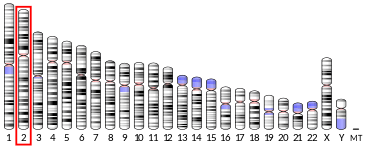SCG2
SCG2, also called secretogranin II (chromogranin C), is a protein which in humans is encoded by the SCG2 gene.[4]
Function
The protein encoded by this gene is a member of the chromogranin/secretogranin family of neuroendocrine secretory proteins. Studies in rodents suggest that the full-length protein, secretogranin II, is involved in the packaging or sorting of peptide hormones and neuropeptides into secretory vesicles. The full-length protein is cleaved to produce the active peptide secretoneurin, which exerts chemotaxic effects on specific cell types, and EM66, whose function is unknown.[5]
gollark: I hope I haven't made horrible mistakes in my rolling counter thing for onstat!
gollark: Ah, I see.
gollark: Wait, how come it's `[8]` and not passing 8 as an actual parameter?
gollark: It's in-place.
gollark: Maybe it should be `res[8..<^1]` but who knows.
See also
Further reading
- Kirchmair R, Gander R, Egger M, et al. (2004). "The neuropeptide secretoneurin acts as a direct angiogenic cytokine in vitro and in vivo". Circulation. 109 (6): 777–83. doi:10.1161/01.CIR.0000112574.07422.C1. PMID 14970115.
- Ozawa H, Takata K (1995). "The granin family--its role in sorting and secretory granule formation". Cell Struct. Funct. 20 (6): 415–20. doi:10.1247/csf.20.415. PMID 8825061.
- Huttner WB, Gerdes HH, Rosa P (1991). "The granin (chromogranin/secretogranin) family". Trends Biochem. Sci. 16 (1): 27–30. doi:10.1016/0968-0004(91)90012-K. PMID 2053134.
- Stemberger K, Pallhuber J, Doblinger A, et al. (2004). "Secretoneurin in the human aqueous humor and the absence of an effect of frequently used eye drops on the levels". Peptides. 25 (12): 2115–8. doi:10.1016/j.peptides.2004.08.010. PMID 15572199.
- Scammell JG, Reddy S, Valentine DL, et al. (2000). "Isolation and characterization of the human secretogranin II gene promoter". Brain Res. Mol. Brain Res. 75 (1): 8–15. doi:10.1016/S0169-328X(99)00269-7. PMID 10648883.
- Kähler CM, Schratzberger P, Kaufmann G, et al. (2002). "Transendothelial migration of leukocytes and signalling mechanisms in response to the neuropeptide secretoneurin". Regul. Pept. 105 (1): 35–46. doi:10.1016/S0167-0115(01)00379-2. PMID 11853870.
- Beranova-Giorgianni S, Zhao Y, Desiderio DM, Giorgianni F (2006). "Phosphoproteomic analysis of the human pituitary". Pituitary. 9 (2): 109–20. doi:10.1007/s11102-006-8916-x. PMID 16807684.
- Lim J, Hao T, Shaw C, et al. (2006). "A protein-protein interaction network for human inherited ataxias and disorders of Purkinje cell degeneration". Cell. 125 (4): 801–14. doi:10.1016/j.cell.2006.03.032. PMID 16713569.
- Kato A, Kammen-Jolly K, Fischer-Colbie R, et al. (2000). "Co-distribution patterns of chromogranin B-like immunoreactivity with chromogranin A and secretoneurin within the human brainstem". Brain Res. 852 (2): 444–52. doi:10.1016/S0006-8993(99)02229-5. PMID 10678772.
- Schrott-Fischer A, Bitsche M, Humpel C, et al. (2009). "Chromogranin peptides in amyotrophic lateral sclerosis". Regul. Pept. 152 (1–3): 13–21. doi:10.1016/j.regpep.2008.07.009. PMID 18721831.
- Fischer-Colbrie R, Kirchmair R, Kähler CM, et al. (2005). "Secretoneurin: a new player in angiogenesis and chemotaxis linking nerves, blood vessels and the immune system". Curr. Protein Pept. Sci. 6 (4): 373–85. doi:10.2174/1389203054546334. PMID 16101435.
- Hillier LW, Graves TA, Fulton RS, et al. (2005). "Generation and annotation of the DNA sequences of human chromosomes 2 and 4". Nature. 434 (7034): 724–31. doi:10.1038/nature03466. PMID 15815621.
- Lankat-Buttgereit B, Müller S, Schmidt H, et al. (2008). "Knockdown of Pdcd4 results in induction of proprotein convertase 1/3 and potent secretion of chromogranin A and secretogranin II in a neuroendocrine cell line". Biol. Cell. 100 (12): 703–15. doi:10.1042/BC20080052. PMID 18549351.
- Stridsberg M, Eriksson B, Janson ET (2008). "Measurements of secretogranins II, III, V and proconvertases 1/3 and 2 in plasma from patients with neuroendocrine tumours". Regul. Pept. 148 (1–3): 95–8. doi:10.1016/j.regpep.2008.03.007. PMID 18448176.
- Gerhard DS, Wagner L, Feingold EA, et al. (2004). "The status, quality, and expansion of the NIH full-length cDNA project: the Mammalian Gene Collection (MGC)". Genome Res. 14 (10B): 2121–7. doi:10.1101/gr.2596504. PMC 528928. PMID 15489334.
- Wen G, Wessel J, Zhou W, et al. (2007). "An ancestral variant of Secretogranin II confers regulation by PHOX2 transcription factors and association with hypertension". Hum. Mol. Genet. 16 (14): 1752–64. doi:10.1093/hmg/ddm123. PMC 2695823. PMID 17584765.
- Yon L, Guillemot J, Montero-Hadjadje M, et al. (2003). "Identification of the secretogranin II-derived peptide EM66 in pheochromocytomas as a potential marker for discriminating benign versus malignant tumors". J. Clin. Endocrinol. Metab. 88 (6): 2579–85. doi:10.1210/jc.2002-021748. PMID 12788858.
- Strausberg RL, Feingold EA, Grouse LH, et al. (2002). "Generation and initial analysis of more than 15,000 full-length human and mouse cDNA sequences". Proc. Natl. Acad. Sci. U.S.A. 99 (26): 16899–903. doi:10.1073/pnas.242603899. PMC 139241. PMID 12477932.
- Wu C, Ma MH, Brown KR, et al. (2007). "Systematic identification of SH3 domain-mediated human protein-protein interactions by peptide array target screening". Proteomics. 7 (11): 1775–85. doi:10.1002/pmic.200601006. PMID 17474147.
- Li L, Hung AC, Porter AG (2008). "Secretogranin II: a key AP-1-regulated protein that mediates neuronal differentiation and protection from nitric oxide-induced apoptosis of neuroblastoma cells". Cell Death Differ. 15 (5): 879–88. doi:10.1038/cdd.2008.8. PMID 18239671.
References
- GRCh38: Ensembl release 89: ENSG00000171951 - Ensembl, May 2017
- "Human PubMed Reference:". National Center for Biotechnology Information, U.S. National Library of Medicine.
- "Mouse PubMed Reference:". National Center for Biotechnology Information, U.S. National Library of Medicine.
- Gerdes HH, Rosa P, Phillips E, Baeuerle PA, Frank R, Argos P, Huttner WB (July 1989). "The primary structure of human secretogranin II, a widespread tyrosine-sulfated secretory granule protein that exhibits low pH- and calcium-induced aggregation". J. Biol. Chem. 264 (20): 12009–15. PMID 2745426.
- "Entrez Gene: SCG2".
This article incorporates text from the United States National Library of Medicine, which is in the public domain.
This article is issued from Wikipedia. The text is licensed under Creative Commons - Attribution - Sharealike. Additional terms may apply for the media files.

